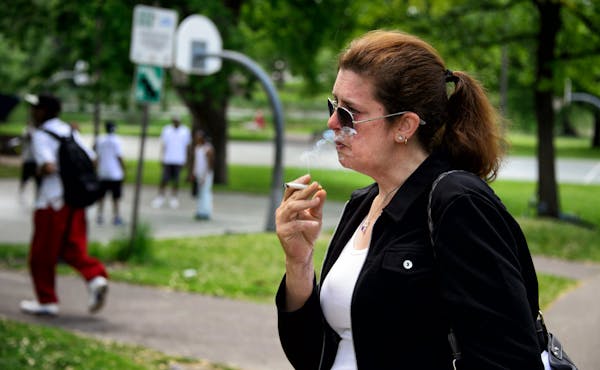The first generation of Minnesotans raised in a world of counter-smoking campaigns — a world in which lighting up is compared to being trapped on a queasy roller coaster ride — is leading a sharp decline in tobacco use.
The share of Minnesotans who smoke dropped from 16.1 percent in 2010 to 14.4 percent in 2014, according to survey results released Thursday, and the number of smokers aged 18 to 24 dropped the fastest, from 21.8 percent to 15.3 percent.
The decline meant, for the first time in the 15-year history of the statewide survey, that the youngest adults in Minnesota were no longer the most likely to smoke.
Youth might be a time of rebellion and experimentation, but today's young adults "see smokers stuck outside. They see their parents and peers quitting, or not starting," said Raymond Boyle, director of research programs for ClearWay Minnesota, the nonprofit agency that produced the survey along with the Minnesota Department of Health. "So you've got just a huge shifts in norms."
Smoking is a known risk factor for lung cancer, and almost single-handedly a cause of chronic obstructive pulmonary disease. The U.S. Centers for Disease Control and Prevention has linked it to 5,900 deaths in the state each year.
Marriage remains a compelling force against tobacco use, accounting for 67 percent of Minnesotans in the survey who successfully quit the habit, and 60 percent of Minnesotans who never started smoking in the first place. Smoking tended to beget smoking, by comparison, as 45 percent of smokers indicated that they lived with someone else who also used tobacco products.
Health officials attributed the decline in smoking to a variety of factors, including public-health advertising and quit-smoking resources made available after Minnesota's landmark legal settlement with the tobacco industry in 1998.
A doubling of state tobacco taxes in 2013, from $1.60 per pack to $3.35, also played a measurable role. Price motivated 44 percent of smokers in the survey to try to quit in 2014, though only 19 percent of them ultimately succeeded, the survey found.
And while health officials have long argued that e-cigarettes are ineffective at helping people wean themselves from traditional tobacco products, the survey found that 45 percent of smokers who successfully quit in the past year used e-cigarettes in the process.
"We have no strong advice to give them," Boyle said. "What it says to me is there is a whole bunch of smokers who want to quit."
Cold turkey
Apple Valley horticulturalist Victoria Russell said her boyfriend made a New Year's resolution to quit, and is using e-cigarettes in gradually reduced amounts to replace the feeling of a cigarette. "So far, so good," said Russell, 25.
Chris Bosse, a former state snowplow driver, described a more draconian approach from 2010. She said her doctor drew an imaginary line in the clinic and told her to pick a side — life or death. "I quit that day cold turkey," the 43-year-old said.
For those who try to quit, the survey data suggests young adults either have the most stick-to-itiveness, or the most struggles. Among 18- to 24-year-olds who tried to quit smoking last year, more than 36 percent did so at least four times. By comparison, most adults 25 and older tried to quit once and called it a year.
The important thing is for smokers to at least try to quit, Boyle said, and to use resources such as ClearWay's free support services. While more than half of Minnesota smokers tried to quit last year, the national goal is 80 percent.
The state's Clean Indoor Air Act has driven many smokers outdoors, but Boyle said he was impressed by the 61 percent of tobacco users who banned smoking in their own homes.
"Nobody is telling them to do that," he said. "They are doing that on their own."
Minnesotans age 25 to 44 now have the highest smoking rate, at 19 percent. As the youngest adults age up, that trend could change as well.
The survey of 9,000 Minnesotans did not include children, but data from another source, the Minnesota Student Survey, indicates they too are making changes. Only 7.2 percent of ninth-graders had smoked cigarettes in the 30 days before completing that student survey in 2013, down from 18.7 percent in 2001.
Jeremy Olson • 612-673-7744

This retired journalist changed professional wrestling from Mankato

All-Metro Sports Awards: Here are the 2023 winners

